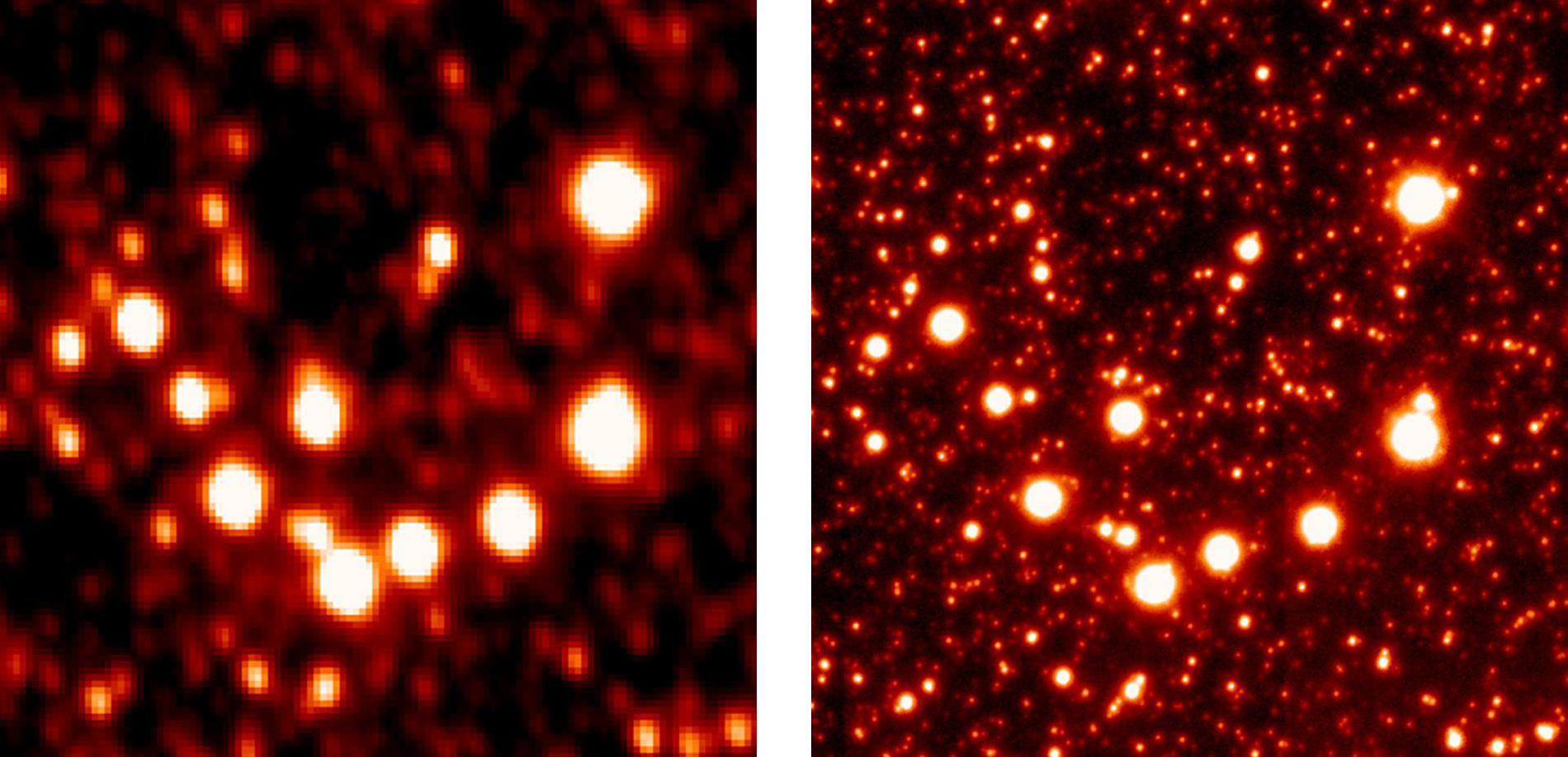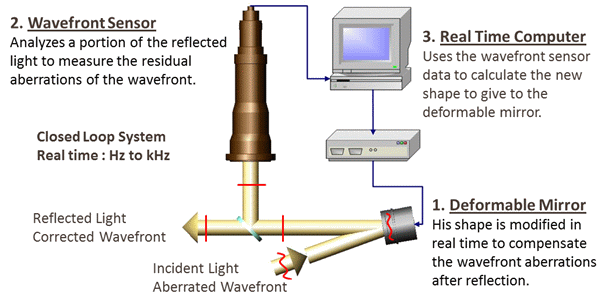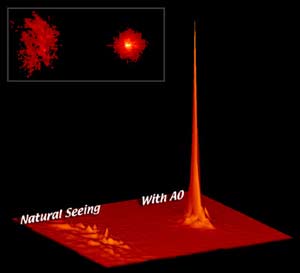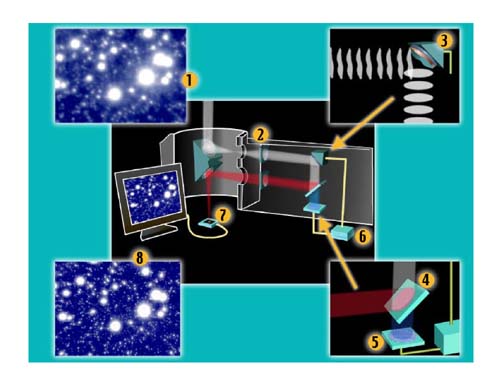What problem is adaptive optics designed to correct. Given the high coherence and monochromaticity of a laser the technique is more straightforward than for more common white-light applications of the astronomical applications. Adaptive optics is designed to compensate for
Adaptive Optics Is Designed To Compensate For, Adaptive optical systems are designed to compensate for wave-front errors caused by atmospheric turbulence. Adaptive optics techniques for real-time compensation of blooming in laser beams were developed in the late 1960s. The Adaptive Optics AO for the Gran Telescopio Canarias GTC corrects the effect of the atmospheric turbulence on the light to exploit the high spatial resolution capability of GTC. The system allows compensating for the influence of atmospheric disturbances up to 200 Hz in terms of sine.
 Center For Adaptive Optics Why Ao From cfao.ucolick.org
Center For Adaptive Optics Why Ao From cfao.ucolick.org
This system is designed to compensate the static and dynamic wavefront errors in the laser generator and amplifier by pre-compensation manner which includes a 45-channel deformable mirror two Shack-Hartmann wavefront sensors with 10x10 sub-apertures a 45-channel high voltage amplifier and a wavefront control computer. Photo courtesy of Gemini Observatory and Canada-France-Hawaii TelescopeCoelumJean-Charles. Aberrations are distortions in the phase of the light waves that may be present in microscopes either due to imperfections in the optics or due to. Erkmen38 Samuel Dolinar3 Moshe Tur4 Mark A.
Retinal imaging using AO aims to compensate for higher order aberrations originating from the cornea and the lens.
Read another article:
A The opacity of the Earths atmosphere B Defects in the optical figuring such as with the adaptive optics on the Hubble Telescope C Slight tracking errors in trying to compensate for our unsteady rotation D The effects of atmospheric turbulence E The absorption of ultraviolet by the ozone layer. The first light Adaptive Optics AO architecture for TMT has been designed to provide diffraction-limited wavefront quality and high sky coverage in the near infrared IR for the first TMT science instruments IRIS and MODHIS. Shapiro7 and Alan E. A The opacity of the Earths atmosphere B Defects in the optical figuring such as with the adaptive optics on the Hubble Telescope C Slight tracking errors in trying to compensate for our unsteady rotation D The effects of atmospheric turbulence E The absorption of ultraviolet by the ozone layer. The adaptive optics market is expected to register a growth at a CAGR of 389 in the forecast period 2021-2026.
 Source: sciencedirect.com
Source: sciencedirect.com
Shapiro7 and Alan E. Aberrations are distortions in the phase of the light waves that may be present in microscopes either due to imperfections in the optics or due to. Given the high coherence and monochromaticity of a laser the technique is more straightforward than for more common white-light applications of the astronomical applications. Photo courtesy of Gemini Observatory and Canada-France-Hawaii TelescopeCoelumJean-Charles. Pi Shaped Lqg Control Design For Adaptive Optics Systems Sciencedirect.
 Source: spie.org
Source: spie.org
Given the high coherence and monochromaticity of a laser the technique is more straightforward than for more common white-light applications of the astronomical applications. In adaptive optics AO one uses a dynamically reconfigurable optical element to correct aberrations. Retinal imaging using AO aims to compensate for higher order aberrations originating from the cornea and the lens. It was originally proposed to correct for the blurring effect of atmospheric turbulence on images in ground-based. Adaptive Optics Widens Its View.
 Source: nature.com
Source: nature.com
An adaptive optics system tries to correct these distortions using a wavefront sensor which takes some of the astronomical light a deformable mirror that lies in the optical path and a computer that receives input from the. Given the high coherence and monochromaticity of a laser the technique is more straightforward than for more common white-light applications of the astronomical applications. In the context of ground-based astronomy adaptive optics is used to compensate for rapidly changing image distortions due to turbulence in the Earths atmosphere. Adaptive optical systems are designed to compensate for wave-front errors caused by atmospheric turbulence. Adaptive Optics For High Resolution Imaging Nature Reviews Methods Primers.
 Source: sciencedirect.com
Source: sciencedirect.com
This system is designed to compensate the static and dynamic wavefront errors in the laser generator and amplifier by pre-compensation manner which includes a 45-channel deformable mirror two Shack-Hartmann wavefront sensors with 10x10 sub-apertures a 45-channel high voltage amplifier and a wavefront control computer. Photo courtesy of Gemini Observatory and Canada-France-Hawaii TelescopeCoelumJean-Charles. How do adaptive optics correct the image. Aberrations are distortions in the phase of the light waves that may be present in microscopes either due to imperfections in the optics or due to. Adaptive Optics An Overview Sciencedirect Topics.
 Source: researchgate.net
Source: researchgate.net
Adaptive optics technology has been used to improve the performance of optical systems by reducing the effect of incoming wavefront distortions by deforming a mirror in order to compensate for the distortion. The AOSDK allows the user to take advantage of an array of techniques to compensate for turbulence that can otherwise distort laser beams over. Adaptive optical systems are designed to compensate for wave-front errors caused by atmospheric turbulence. At the core of an adaptive optics system is a deformable mirror. Ngs Adaptive Optics Performance On Lbt 50 80 Long Exposure Strehl Download Scientific Diagram.
 Source: photonics.com
Source: photonics.com
In the context of ground-based astronomy adaptive optics is used to compensate for rapidly changing image distortions due to turbulence in the Earths atmosphere. Adaptive optical systems are designed to compensate for wave-front errors caused by atmospheric turbulence. This system is designed to compensate the static and dynamic wavefront errors in the laser generator and amplifier by pre-compensation manner which includes a 45-channel deformable mirror two Shack-Hartmann wavefront sensors with 10x10 sub-apertures a 45-channel high voltage amplifier and a wavefront control computer. A The opacity of the Earths atmosphere B Defects in the optical figuring such as with the adaptive optics on the Hubble Telescope C Slight tracking errors in trying to compensate for our unsteady rotation D The effects of atmospheric turbulence E The absorption of ultraviolet by the ozone layer. Adaptive Optics Look Farther Than Ever Before Features May 2018 Photonics Spectra.
 Source: akaoptics.com
Source: akaoptics.com
In general however adaptive optical systems cannot sense wave-front. The Adaptive Optics AO for the Gran Telescopio Canarias GTC corrects the effect of the atmospheric turbulence on the light to exploit the high spatial resolution capability of GTC. Retinal imaging using AO aims to compensate for higher order aberrations originating from the cornea and the lens. Adaptive optics technology has been used to improve the performance of optical systems by reducing the effect of incoming wavefront distortions by deforming a mirror in order to compensate for the distortion. Adaptive Optics Close Loop System.
 Source: atnf.csiro.au
Source: atnf.csiro.au
The Adaptive Optics Module AOM is the core engine of MAVIS devoted to multi-conjugate wavefront sensing and correction and designed to deliver a 30x30 arcsec2 corrected field of view to the scientific instruments. Erkmen38 Samuel Dolinar3 Moshe Tur4 Mark A. The Adaptive Optics AO for the Gran Telescopio Canarias GTC corrects the effect of the atmospheric turbulence on the light to exploit the high spatial resolution capability of GTC. The Adaptive Optics Module AOM is the core engine of MAVIS devoted to multi-conjugate wavefront sensing and correction and designed to deliver a 30x30 arcsec2 corrected field of view to the scientific instruments. Adaptive Optics.

Aberrations are distortions in the phase of the light waves that may be present in microscopes either due to imperfections in the optics or due to. To effectively launch the laser beam through a telescope and achieve a high photon density at the object in orbit the beam needs to be shaped in order to compensate for dispersion caused by atmospheric turbulence. Adaptive optics techniques for real-time compensation of blooming in laser beams were developed in the late 1960s. Whilst adaptive optics compensates for atmospheric distortions the deformation of the large primary mirrors is corrected by active optics as discussed on the next page. How Did Adaptive Optics Ao Technology Get Started Who Was Involved And How Were They First Applied To Astronomical Telescopes Quora.
 Source: atnf.csiro.au
Source: atnf.csiro.au
Adaptive optics AO is employed to achieve this task. Provide better angular resolution than orange light. A The opacity of the Earths atmosphere B Defects in the optical figuring such as with the adaptive optics on the Hubble Telescope C Slight tracking errors in trying to compensate for our unsteady rotation D The effects of atmospheric turbulence E The absorption of ultraviolet by the ozone layer. Whilst adaptive optics compensates for atmospheric distortions the deformation of the large primary mirrors is corrected by active optics as discussed on the next page. Adaptive Optics.
 Source: photonics.com
Source: photonics.com
In adaptive optics AO one uses a dynamically reconfigurable optical element to correct aberrations. The adaptive optics market is expected to register a growth at a CAGR of 389 in the forecast period 2021-2026. In addition they may also correct for wave-front errors associated with fixed optical aberrations in the host telescope. An adaptive optics system tries to correct these distortions using a wavefront sensor which takes some of the astronomical light a deformable mirror that lies in the optical path and a computer that receives input from the. Adaptive Optics Look Farther Than Ever Before Features May 2018 Photonics Spectra.
 Source: eso.org
Source: eso.org
An adaptive optical system that implements a phase conjugation algorithm designed to compensate for the effect of atmospheric turbulence the propagating laser beam is presented. Adaptive optics compensates for turbulence and temperature differences in the Earths atmosphere to enable a weapons-grade laser to shoot down incoming ballistic missiles. This system is designed to compensate the static and dynamic wavefront errors in the laser generator and amplifier by pre-compensation manner which includes a 45-channel deformable mirror two Shack-Hartmann wavefront sensors with 10x10 sub-apertures a 45-channel high voltage amplifier and a wavefront control computer. The closest thing we have to adaptive optics for the typical amateur is the lucky imaging technique used for solar system imaging only instead of reforming the wavefront before it hits the sensor post processing infers what image could result in a multitude of. Adaptive Optics With Mad Eso.
 Source: wikiwand.com
Source: wikiwand.com
Adaptive optics techniques for real-time compensation of blooming in laser beams were developed in the late 1960s. The system allows compensating for the influence of atmospheric disturbances up to 200 Hz in terms of sine. Given the high coherence and monochromaticity of a laser the technique is more straightforward than for more common white-light applications of the astronomical applications. Erkmen38 Samuel Dolinar3 Moshe Tur4 Mark A. Adaptive Optics Wikiwand.
 Source: eso.org
Source: eso.org
This system is designed to compensate the static and dynamic wavefront errors in the laser generator and amplifier by pre-compensation manner which includes a 45-channel deformable mirror two Shack-Hartmann wavefront sensors with 10x10 sub-apertures a 45-channel high voltage amplifier and a wavefront control computer. Adaptive optical elements are useful tools for controlling the shape of laser foci allowing spatially complex phase and amplitude distributions of light. The Adaptive Optics Module AOM is the core engine of MAVIS devoted to multi-conjugate wavefront sensing and correction and designed to deliver a 30x30 arcsec2 corrected field of view to the scientific instruments. What problem is adaptive optics designed to correct. Supersharp Images From New Vlt Adaptive Optics Eso Shqiperia.
 Source: cfao.ucolick.org
Source: cfao.ucolick.org
Adaptive optics technology has been used to improve the performance of optical systems by reducing the effect of incoming wavefront distortions by deforming a mirror in order to compensate for the distortion. At the core of an adaptive optics system is a deformable mirror. Adaptive optical elements are useful tools for controlling the shape of laser foci allowing spatially complex phase and amplitude distributions of light. In this paper we focus on the optical design of the AOM which has been optimized to perform several tasks including. Center For Adaptive Optics Why Ao.







